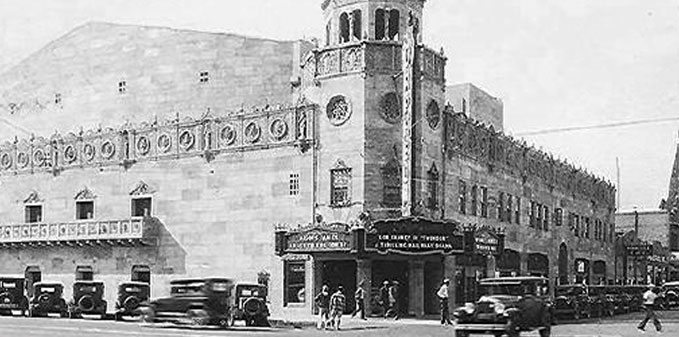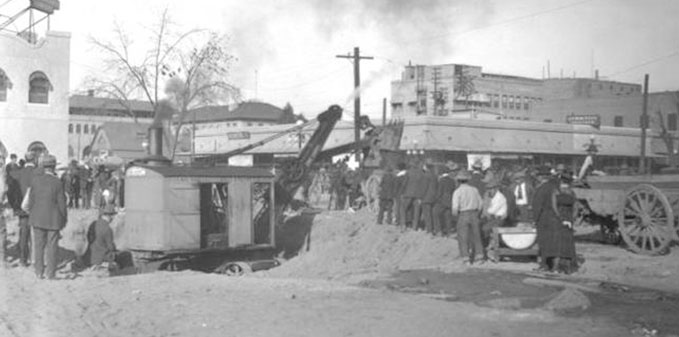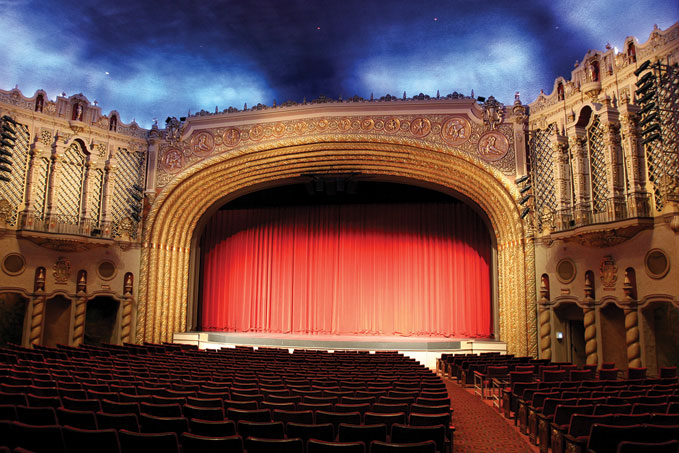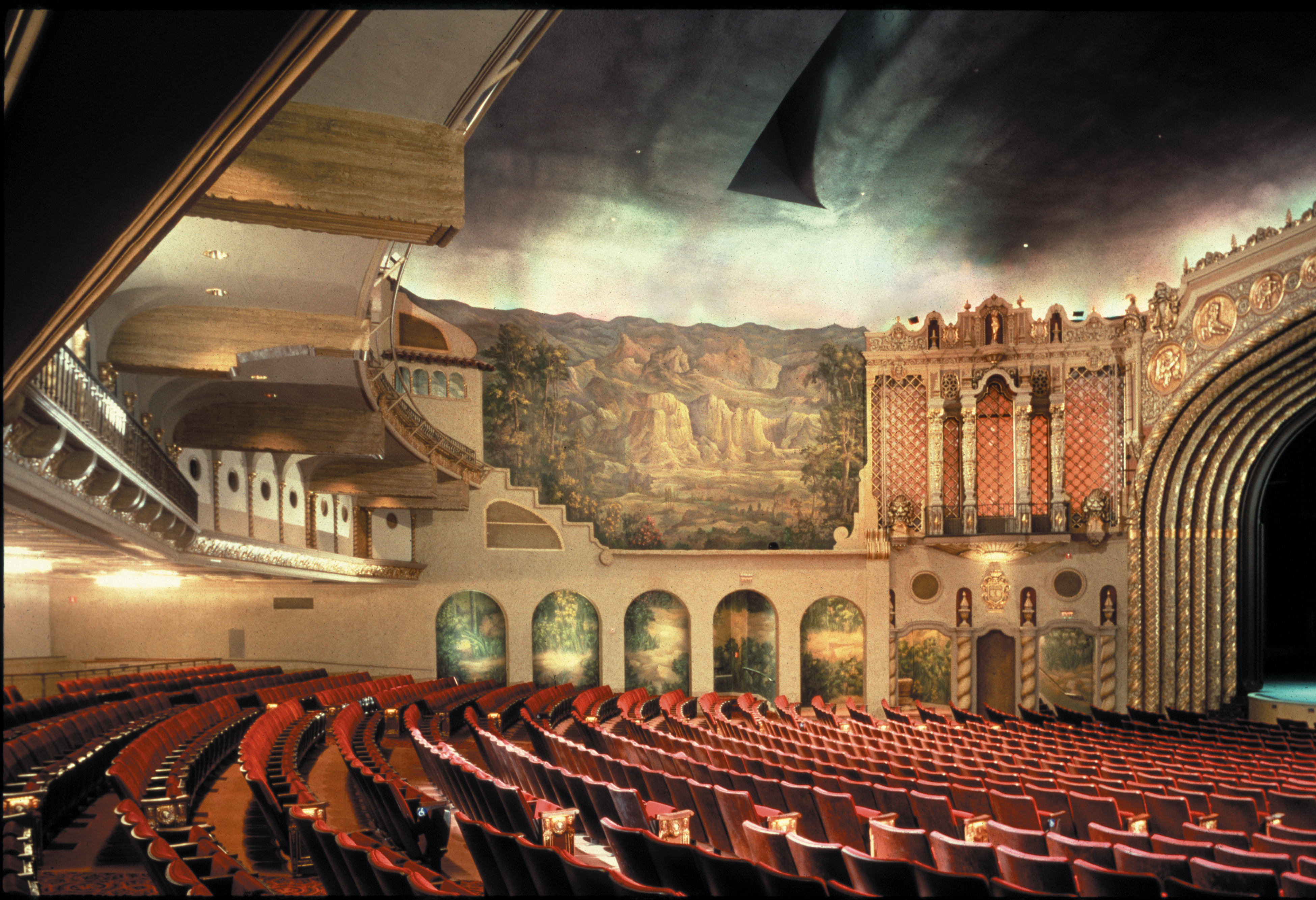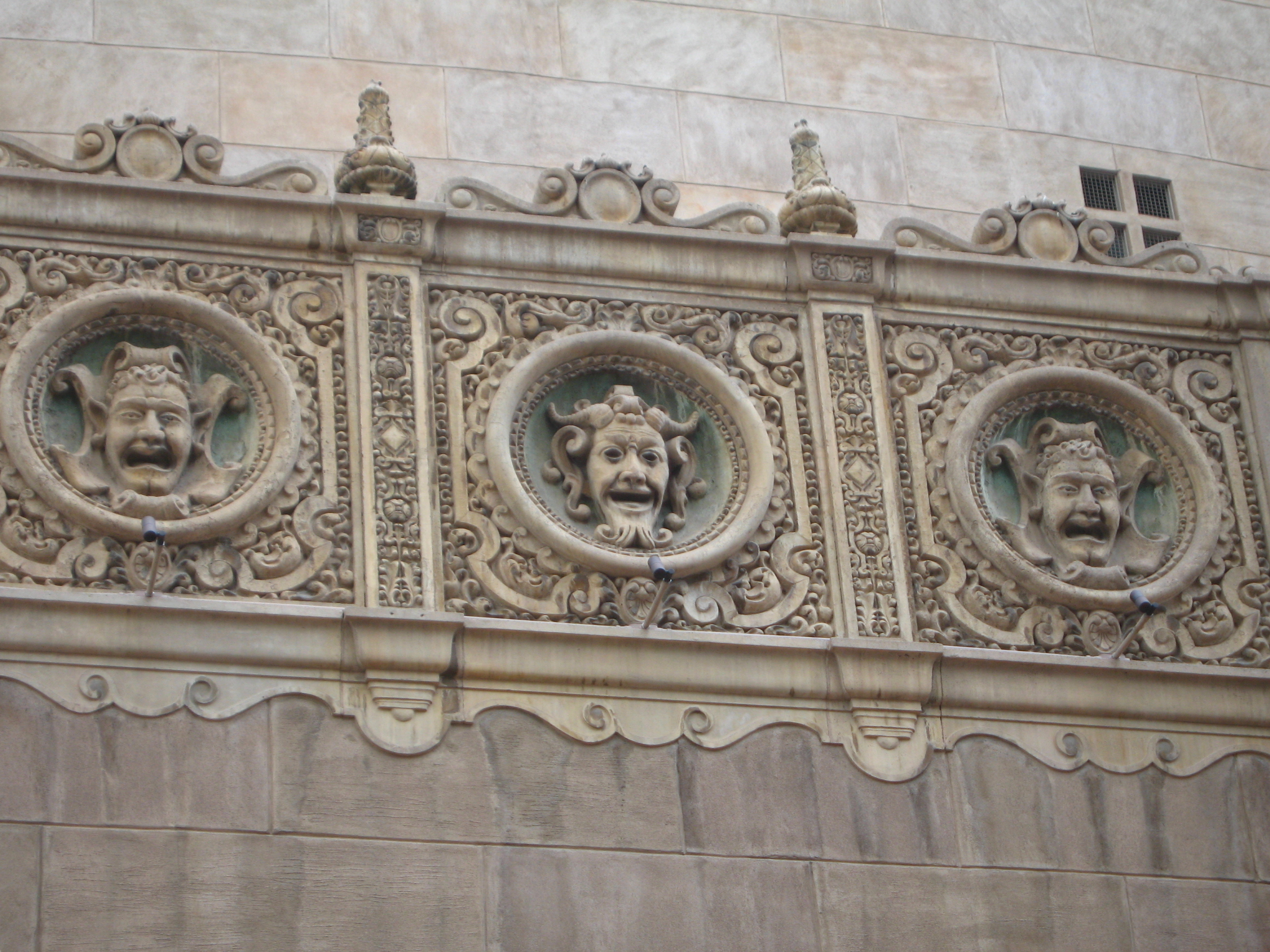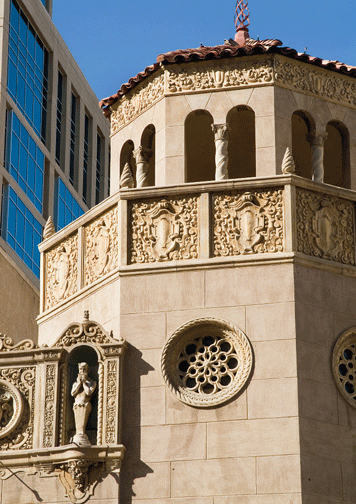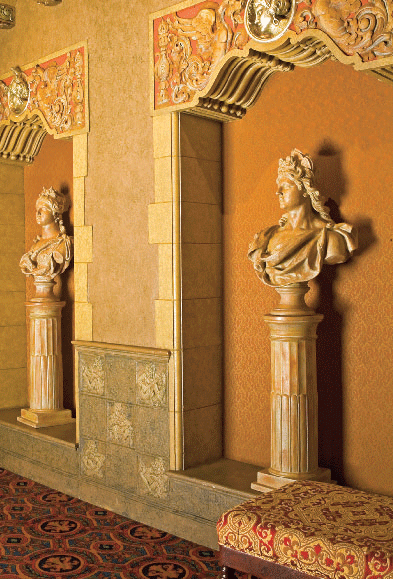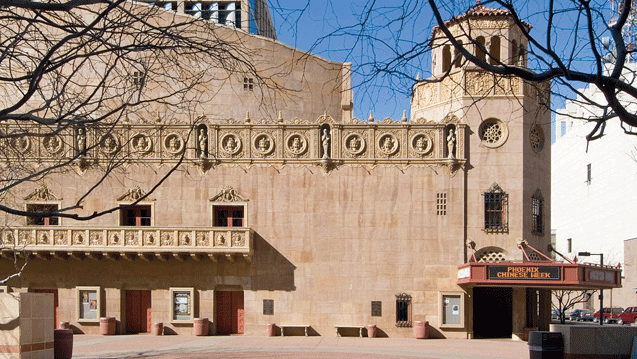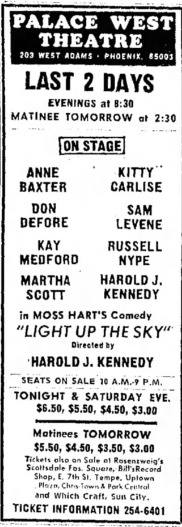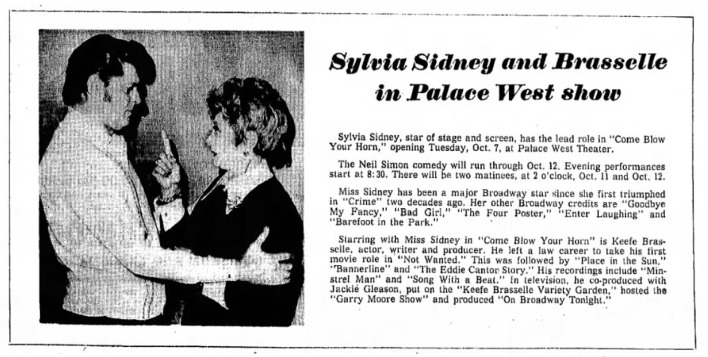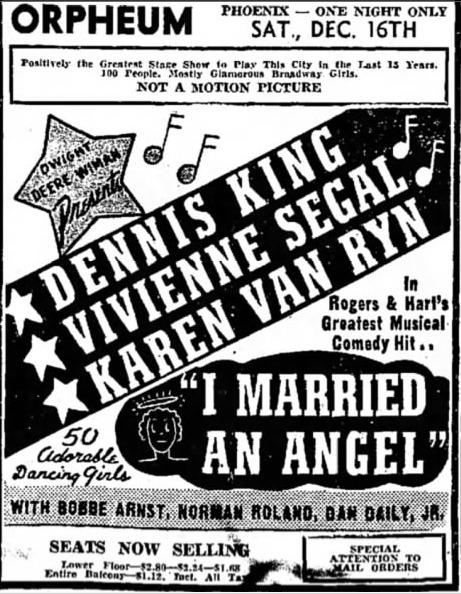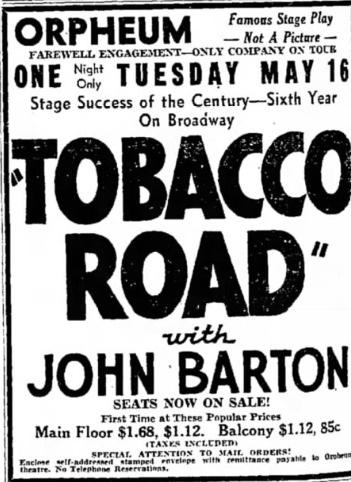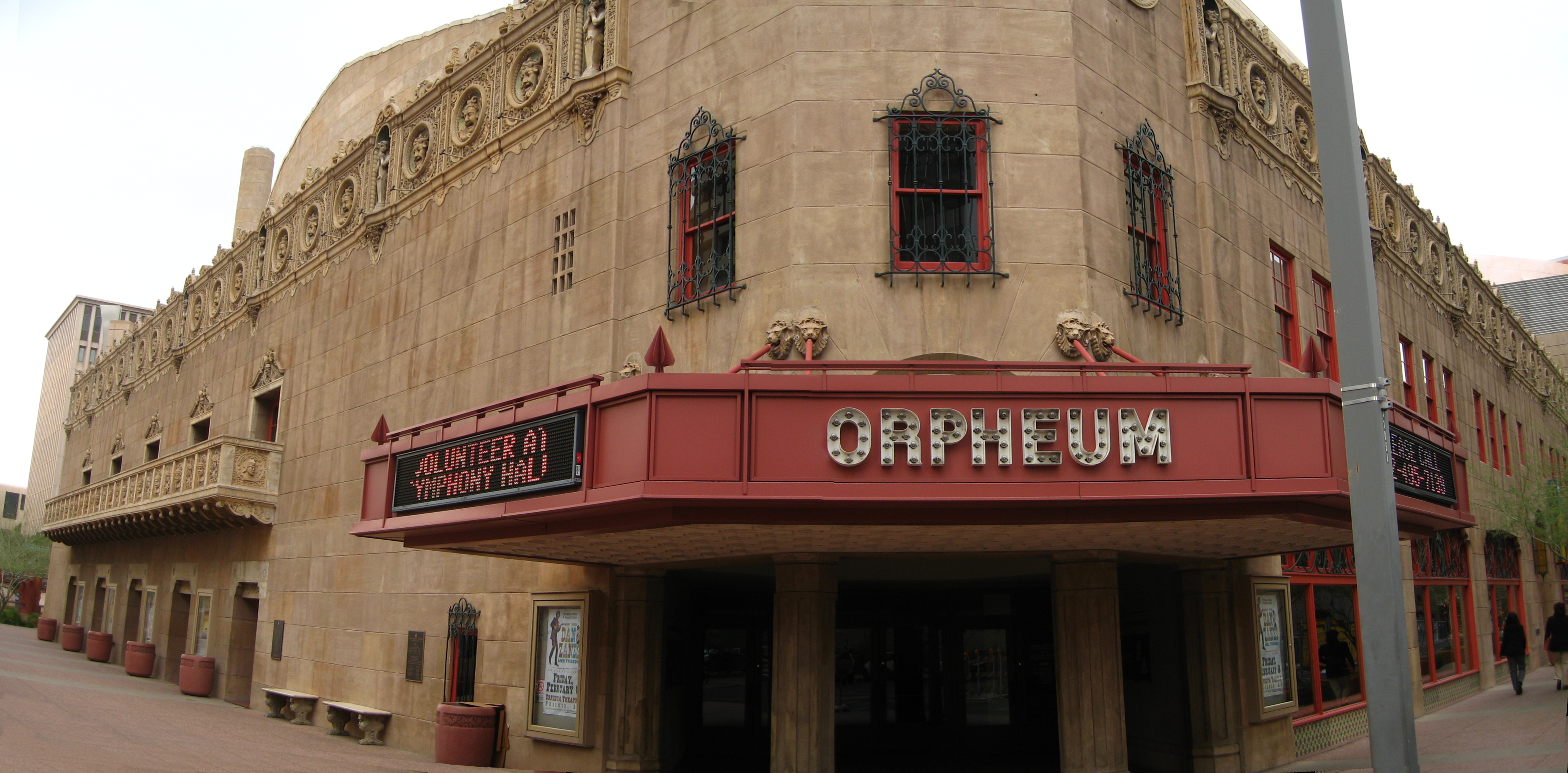
aka PALACE WEST THEATRE
HISTORY
The Orpheum Theatre is a 1,364-seat theater in downtown Phoenix. This venue was originally used for vaudeville acts as part of the nationwide Orpheum Circuit.
Construction began in 1927 and was completed in 1929 for a total cost of $750,000. It was designed by architects Lescher & Mahoney, with Hugh Gilbert associated, and built for owner-operators J.E. Rickards and Harry Nace.
Built in a Spanish Revival style of Spanish Baroque architecture, intricate murals and moldings were an integral part of the design, all meant to give patrons the impression that they were enjoying the shows “al fresco.”
In the 1940s the Orpheum was purchased by the Paramount Pictures chain and renamed, “The Paramount.” In the 60’s Nederlander purchased it to add it as a stop on the Broadway circuit. Throughout the ’60’s until its restoration, it was renamed Palace West.
Throughout the late ’70’s and early ’80’s, the theater was leased to a local Mexican family, the Coronas, who presented Hispanic events and movies. At one point all the murals and moldings were painted black when the Orpheum was used to show Spanish films. It was thought that such decorations would detract from the films.
After falling into disrepair for some years, the Orpheum Theatre was purchased in 1984 by the City of Phoenix, which then began a 12-year, $14 million restoration. The Conrad Schmitt Studios created the transformation and the Orpheum reopened on January 28, 1997, with a performance of Hello, Dolly! starring Carol Channing. (Wikipedia)
The following photographs are courtesy of the Orpheum Theatre and the city of Phoenix.
HISTORIC PHOTOGRAPHS
CURRENT PHOTOGRAPHS
OCTOBER 2004 “Tea at Five,” Theater League, Orpheum Theatre
INTERVIEW: Kyle Lawson, Arizona Republic, Oct. 3, 2004
She was made for making an entrance.
Not tall, really, but with a carriage her mother would have insisted upon as proper posture, contradicted by a slight, angular lurch that brings a coltish eccentricity to her gait.
The hair, abundantly auburn, tumbles about the edges of her face, softening cheekbones etched with a harsh geometry. The voice is flinty, overlaid with a touch of huskiness that, when she chooses, she can use to devastating effect.
Katharine Hepburn?
No. Kate Mulgrew.
When Theater League announced that Mulgrew would appear at the Orpheum Theatre in Tea at Five, a play about Hepburn, the initial reaction was “Of course.”
Few viewers of TV’s Star Trek: Voyager have failed to notice Mulgrew’s resemblance to the legendary film star. Certain camera angles make it seem as if Hepburn has taken over the body of Capt. Kathryn Janeway. It might be disconcerting if it weren’t for the fact that Hepburn would have made a dandy starship captain.
In Mulgrew’s early career, an interviewer would have brought up her resemblance to Hepburn at his peril.
“Growing up, my feelings for Katharine Hepburn were less than affectionate,” Mulgrew says. “That can be put down to frustration over being so often compared to her. To a young girl who wanted to be an actress in her own right, such off-the-wall comparisons were odious.”
The years have mellowed that girl.
“Now that I’m older, I love them,” says Mulgrew, 49.
Because the cheekbones and the voice were gifts of birth, she’s not above using them in her portrayal of Hepburn.
“On the stage, the lighting takes over,” Mulgrew says, on the phone from her home in Cleveland. “Even I must admit the likeness is startling.”
It stops there. Mulgrew says she was never interested in doing a literal impersonation of Hepburn.
“That’s been done by every drag queen from here to Texas,” she says. “I never met the lady, but I have done a great deal of research. My Hepburn is a mixture of reality and my imagination.”
For Mulgrew, the key came when she finally understood what drove Hepburn.
“Underneath that Yankee grit was a great vulnerability, almost sadness,” Mulgrew says. “There were terrible things in her life.”
The greatest tragedy was her brother’s death when she was 13. Hepburn found her sibling hanging from the rafters. She cut him down. Her father forbid her to talk of it. Hepburns did not commit suicide.
“She buried it deeply, but she never escaped the grief,” Mulgrew says. “It is why she took such a direct aim on Hollywood. What could she lose that she hadn’t already lost? She spent the rest of her life trying to understand why her brother killed himself, but she never did.”
A new film, The Aviator (due in December), deals with Hepburn’s affair with Howard Hughes in the 1930s. Tea at Five mentions it but concentrates on Hepburn’s union with Spencer Tracy. That relationship lasted more than 30 years, although Tracy’s Catholicism kept him from divorcing his wife and marrying Hepburn.
“Spencer Tracy was the love of her life – he was her life,” Mulgrew says. “Howard Hughes wasn’t important to her. His eccentricities drove her nuts – though, God knows, she was the queen of eccentricities herself.”
Mulgrew is never surprised when Hepburn’s name pops up on lists of all-time great role models for women.
“She wouldn’t take ‘no’ for an answer, and when she got a ‘no’ it didn’t bother her at all,” Mulgrew says. “Her attitude was, ‘I’m going to do it my way,’ and she injected herself straight into Hollywood and broke down the old boys’ club. Any woman would respond to that strength and keen intelligence. Katharine Hepburn was not a bimbo, that’s for sure.”
But would she have been a starship captain?
Mulgrew thinks not.
“In all my research, I never came across any indication that Hepburn had the slightest interest in space or the future. She was very much about the here and now. Happily, I get to keep the starship for myself.”
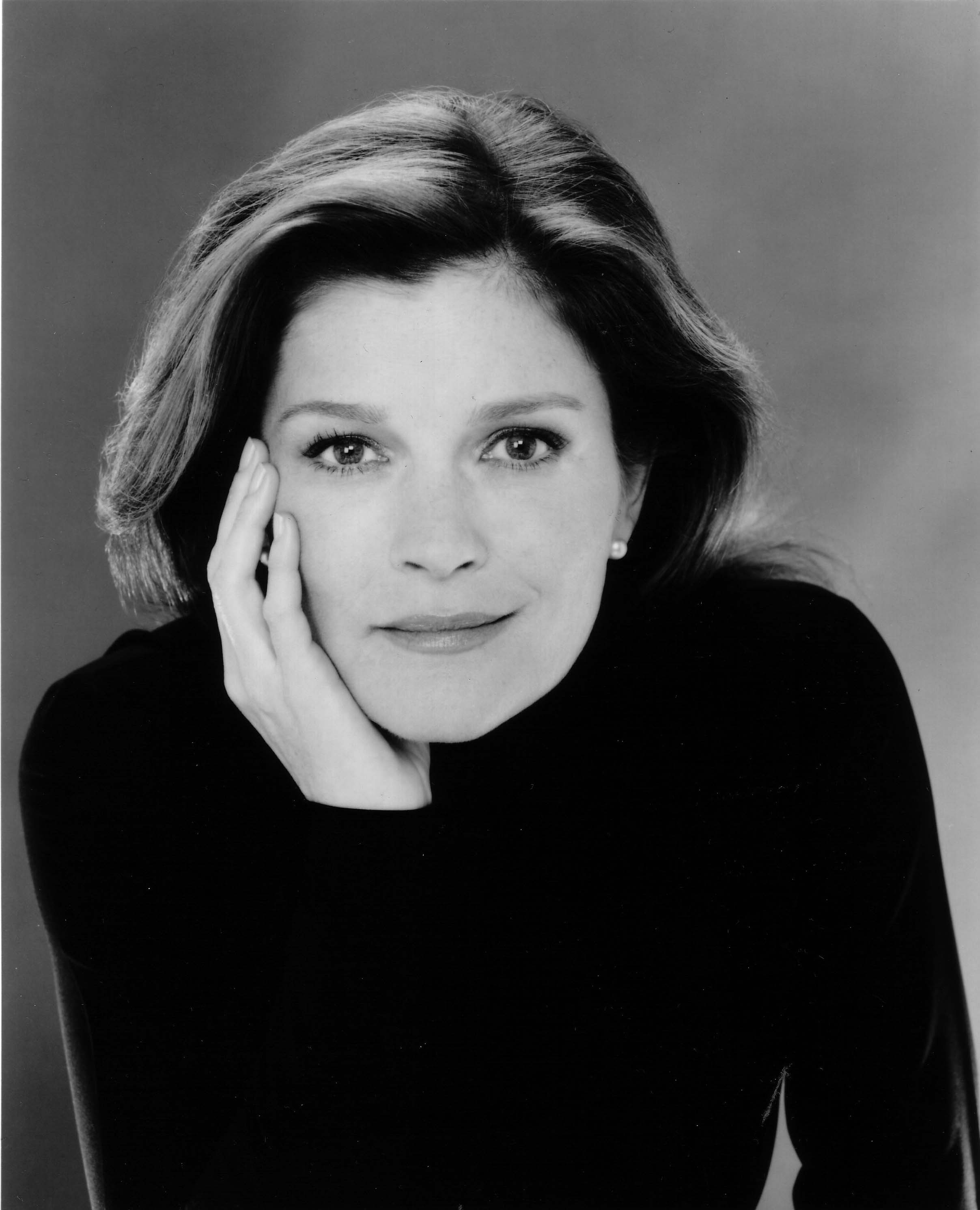
The following story detailing the history of downtown’s Orpheum Theatre appeared in American Bungalow, a delightful magazine that, if you aren’t reading it, you should be. Information and subscriptions are available at http://www.americanbungalow.com
THE STORY OF Phoenix’s Orpheum Theatre—which opened in January 1929, skirted demolition in the 1980s and was restored to its original splendor in the mid-1990s — follows the arc of Phoenix’s history through nearly eight decades, from the glory days of the city’s boom years in the twenties, through the depression, to Post–World War II suburban growth and urban abandonment, and finally to the renaissance of a vibrant downtown core over the past decade.
The Orpheum’s survival is not just a small miracle of historic preservation accomplished through an episode of cultural, civic and political imagination. It can also be seen as a monument to the age of vaudeville, which the social historian Robert Snyder has called “the biblical era of twentieth-century American show business.”
Vaudeville’s stars, Snyder writes, “invigorated early radio, film, and television. Its format, a series of acts strung together, was transplanted to radio and television variety shows. Its theater circuits spawned chains of movie theaters. Its mass audience — constructed by calculating entrepreneurs, assembled in public, dynamically varied in its composition, significantly urban in its origins, knowledgeable and vocal in its demands — was the defining element of American popular culture for the first half of the twentieth century…
“Although vaudeville is now part of a receding past, in its history we can glimpse both a world we have lost and the embryonic forms of enduring patterns in American culture.”
Phoenix’s Orpheum was one of the last in the legendary string of theater “palaces” built across the U.S. to present vaudeville shows produced by the Orpheum Circuit, which originated in New York City in the 1890s. Built just as vaudeville was being eclipsed by the movies, the Phoenix Orpheum proved durable and flexible enough to adapt to the rise of motion pictures as the dominant American entertainment medium. Writing in The Arizona Republic in 2004, Cathy Creno captured the atmosphere of the city when the Orpheum appeared on the scene.
“Flappers, vaudeville, Buck Rogers and Douglas Fairbanks Jr. were all the rage when the Orpheum Theatre opened in January 1929.
“Silent pictures were on their way out, the Great Depression had yet to hit. And Phoenix was finally on the map—having grown from an isolated farming community to a budding city with streetcars, a major railway line and a population of 49,000.
“The town’s mood was boisterous and boosterish.
“‘Phoenix fastest growing city of size in country,’ boasted a headline in The Arizona Republican on Jan. 5, the day the Orpheum opened.
“Home builders developing the ritzy Encanto-Palmcroft neighborhood put ads in newspapers nationwide, urging Easterners to come west and buy an ‘estate’ with an English Tudor– or Spanish Colonial–style home.
“Encanto Park was still a farm field. But big buildings—a new city hall and county courthouse, Hotel Westward Ho, the San Carlos Hotel and the Luhrs Tower—were springing up just a few miles away.
“Probably none was greeted with more fanfare than the Orpheum, built at Second Avenue and Adams by Harry Nace and J.E. Rickards…
“Newspapers called the $750,000 movie palace the most luxurious theater west of the Mississippi. Patrons lined up for blocks—not only for movies and vaudeville shows but for the theater’s chilled, purified air and an opportunity to see projected clouds and stars from what appeared to be the courtyard of a 15th-century Moorish palace.”
The new theater was “state of the art” for its time. The audience chamber was designed to create the illusion of sitting in the courtyard of a Spanish villa, beneath a sky that changed from golden sunset to starry night, with views of a distant landscape above the sidewalls. Ornate plaster work inside and out was done in Spanish Medieval and Baroque style, with guilt “ropes” arching over the stage.
Zodiac designs in the lobby door panels, a peacock design on the circular staircase, and colorful murals complemented intricately detailed arches, niches and columns in the lobbies.
Over the next 20 years, during the heyday of Hollywood films, going to the movies to see the stars of the era perform in the defining genres of Hollywood’s golden age—westerns, film noir, screwball comedies, musicals, historical adventures—was how most Americans got their entertainment.
The newsreels of the day vividly—often feverishly—portrayed the national experience through Depression, war, “the Bomb,” the Red Scare and the early years of the Cold War. Producers of “educational” short films found opportunities to slake the public thirst for guidance on everything from teenage dating to the evils of marijuana. For dessert, there were the imperishable Warner Brothers cartoons.
But just as the movies had eaten away at vaudeville, television steadily eroded the audience for movies at the same time that the suburbs were drawing people out of the central city. Downtown Phoenix’s center of gravity, once neatly bisected by Central Avenue, began moving east, leaving the Orpheum and the rest of the area west of Central more or less an afterthought.
In the end, that turned out to be one of the key circumstances leading to the theater’s salvation. While redevelopers worked their way east, swallowing up the old Fox and Rialto theaters, the Orpheum (after a brief interlude as the “Palace West” under the ownership of Broadway theater producer James Nederlander) took on a new life catering to Latino movie audiences.
But over the years, the theater’s owners had all but tarred the buildings elaborate interior spaces. The impressive wall murals were painted black, four of the seven proscenium “ropes” were removed to widen the stage, and much of the fabulous lobby and interior detail had been painted neutral.
That is where things stood through the 1970s and into the ’80s, when the threat that the theater might be bought as the site for a new theater gained momentum. And that is when the Phoenix Junior League sought, and found, enough community support to persuade the city to buy the theater to allay the immediate threat of demolition, with the idea that it might eventually be restored. It was as if the city had heeded the warning Sophie Tucker, “the last of the red hot mamas,” belted out to a wavering lover in the bluesy 1910 ballad “Some of These Days” —
Some of these days,
Oh, you’ll miss me, honey.
Some of these days,
You’re gonna be so lonely.
Then-Mayor Terry Goddard and a newly formed historic preservation task force embraced the idea, and in 1984 the city bought the theater for $1.5 million. It was placed on the National Register of Historic Places the following year.
In 1985, to celebrate its 50th anniversary, the Junior League of Phoenix donated $50,000 for lobby restoration and an endowment. To raise public support and encourage private-sector donations, the League pledged an additional $150,000 when it established the Orpheum Theatre Foundation two years later.
In 1990, then-Mayor Paul Johnson and the Phoenix City Council made the inspired decision to incorporate the Orpheum restoration into the construction of a new city hall to be built on the south half of the theater’s block. The modern, 20-story city hall building became like a mother to a refurbished Orpheum, sharing water, power, air conditioning and other essential facilities.
Begun in 1994, the restoration was completed in 1997 at a cost of $14 million. Since then, the Orpheum has succeeded as a modern theater capable of handling anything Broadway sends its way. Its marquee again announces the names of first-class productions, drawing thousands of visitors to a vibrant downtown venue, lonely no more.
JANUARY 1971 “Light Up the Sky.” Director: Harold J. Kennedy. Cast: Anne Baxter, Kitty Carlisle, Don Defore, Sam Levene, Kay Medford, Russell Nype, Martha Scott, Harold J. Kennedy.
Arizona Republic, Sept. 28, 1969
Arizona Republic, Dec. 12, 1939
Arizona Republic, April 30, 1939

